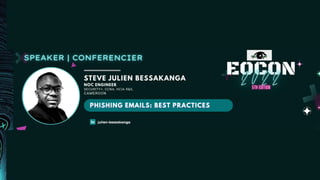
Phishing mails: Bonnes pratiques
- 2. 1. Phishing: What is it? 2.How is a phishing email designed? 3.Why phishing? 4.Types of Phishing 5.What happens if I click on malicious link? 6.Best practices: What can do to stay safe? PLAN
- 3. Phishing: What is it? Phishing email messages, websites, and phone calls are designed to steal money or sensitive information. Cybercriminals can do this by installing malicious software on your computer, tricking you into giving them sensitive information, or outright stealing personal information off of your computer.
- 4. How is a phishing email designed? (1/2) A phishing message is designed to trick you Into doing one of these four things. Click Here! Click an Unsafe Link Open an Unsafe File USERNAME ************ Type your Password Transfer Funds
- 5. How is a phishing email designed? (2/2) Scarcity Urgency Authority Familiarity / Consensus Phishing messages are designed to get you to react quickly without thinking too much.
- 6. Examples • Claims to come from PayPal Includes PayPal logo, but from address is not legitimate (@ecomm360.net). Calls for immediate action using threatening language • Includes hyperlink that points to fraudulent site
- 7. Why phishing? Cyber attackers phish for different reasons, but they all phish. Intelligence Hacktivists Criminals Money Fraud Identity Theft Sensitive Data Network Access Infrastructure Public Web Pages Social Media
- 8. Types of Phishing (1/3) Spear phishing - Phishing attempts directed at specific individuals or companies have been termed spear phishing. Attackers may gather personal information (social engineering) about their targets to increase their probability of success. This technique is, by far, the most successful on the internet today, accounting for 91% of attacks.
- 9. Types of Phishing (2/3) Clone phishing - A type of phishing attack whereby a legitimate, and previously delivered email containing an attachment or link has had its content and recipient address(es) taken and used to create an almost identical or cloned email. The attachment or link within the email is replaced with a malicious version and then sent from an email address spoofed to appear to come from the original sender.
- 10. Types of Phishing (3/3) Voice Phishing (Vishing) - Voice phishing is the criminal practice of using social engineering over the telephone system to gain access to personal and financial information from the public for the purpose of financial reward. Sometimes referred to as 'vishing’, Voice phishing is typically used to steal credit card numbers or other information used in identity theft schemes from individuals.
- 11. What happens if I click on malicious link? Stolen Password Remote Access Ransomware Network Compromise Identity Theft Data Destruction Account Takeover Data Leak
- 12. Best Practices (1/5) Do not click directly on links received by email; always check the address they lead to by hovering over it. The address will appear at the bottom left of the screen.
- 13. Best Practices (2/5) E-mail attachments can be dangerous. Do not open them !
- 14. Best Practices (3/5) E-mail attachments can be dangerous. Do not open them !
- 15. Best Practices (4/5) Once an email containing confidential documents has been sent, delete it from the sent items and from the recycle bin to prevent it from falling into the wrong hands in case of hacking.
- 16. Best Practices (5/5) • Install and maintain antivirus software on your electronic devices. • Use email filters to reduce spam and malicious traffic
- 17. M E R C I ! T H A N K Y O U ! QUESTIONS ?
